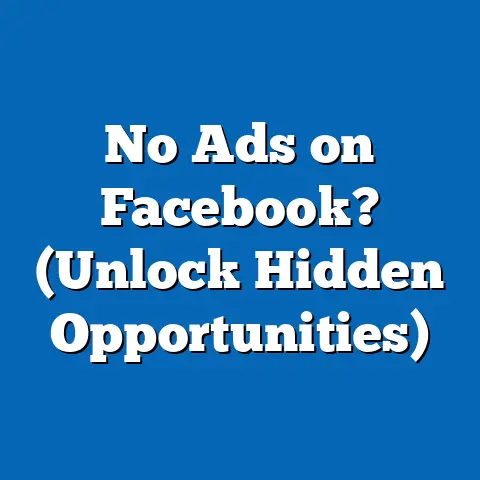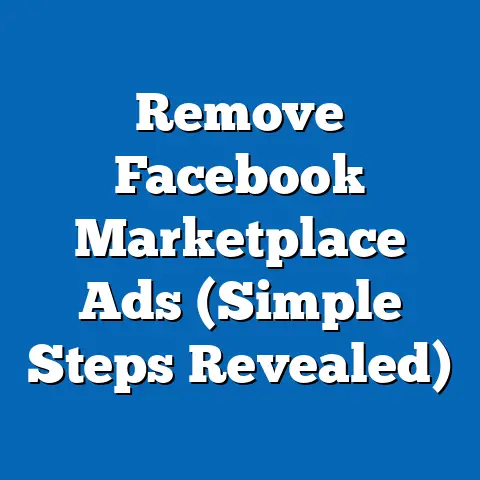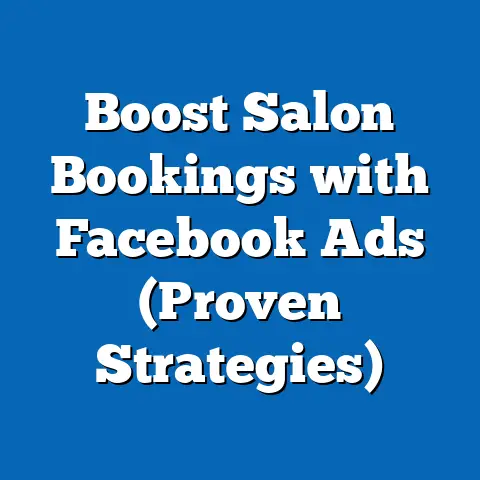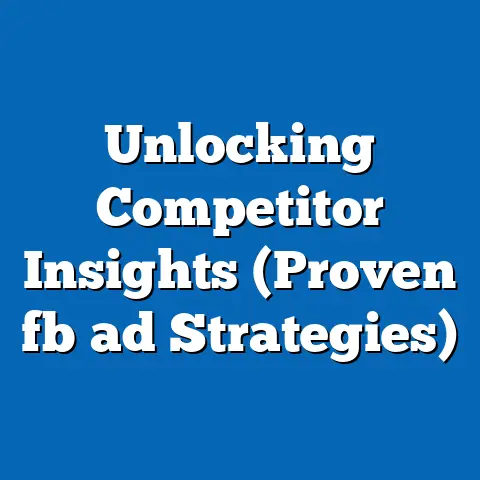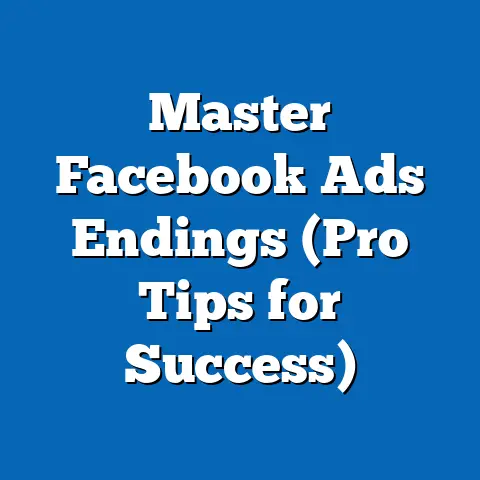Boost Facebook Ads: Secrets to High Conversions (Winning Strategies)
Boost Facebook Ads: Secrets to High Conversions (Winning Strategies)
“I never realized the power of Facebook ads until I saw my sales triple in just a month. It was like unlocking a treasure chest!” – This is the kind of success story I want you to experience. Let’s explore how to make it happen.
Understanding the Facebook Ads Ecosystem
Facebook is a giant, and its advertising platform is equally massive. With billions of active users, it’s a goldmine for businesses looking to reach a broad audience or a highly targeted niche. According to recent statistics, Facebook has over 2.9 billion monthly active users as of early 2024. That’s a huge pool of potential customers! More importantly, Facebook’s advanced targeting capabilities allow you to pinpoint your ideal audience with incredible precision.
Here are some key aspects of the Facebook ads ecosystem I want to cover:
- Facebook’s Significance: Facebook isn’t just about sharing memes and connecting with friends. It’s a powerful marketing tool that, when used correctly, can drive significant results.
- Ad Formats: From eye-catching images to engaging videos, Facebook offers a variety of ad formats to suit different campaign goals.
- Ads Manager: The Facebook Ads Manager is your control center. It’s where you create, manage, and analyze your ad campaigns.
Exploring the Variety of Ad Formats
Facebook offers a plethora of ad formats, each designed to capture attention and drive specific actions. I’ve found that understanding these formats is crucial for tailoring your message effectively.
- Image Ads: Simple, yet effective. A compelling image paired with persuasive copy can be a great way to grab attention.
- Video Ads: Videos are highly engaging and can tell a story in a way that images can’t. Short, impactful videos often perform best.
- Carousel Ads: Showcase multiple products or features in a single ad. This format is perfect for e-commerce businesses.
- Collection Ads: Designed for mobile shopping, collection ads allow users to browse and purchase products directly from the ad.
- Instant Experience Ads: These full-screen ads provide an immersive experience for users, allowing them to explore products or services in detail.
Takeaway: Familiarize yourself with the different ad formats and choose the ones that best align with your campaign goals and target audience.
Mastering the Facebook Ads Manager
The Facebook Ads Manager is the central hub for all your advertising activities. It’s where you’ll create campaigns, define your audience, set your budget, and track your results. I’ve spent countless hours navigating this platform, and I can tell you that mastering it is essential for success.
Here’s a quick rundown of what you can do with the Ads Manager:
- Create Campaigns: Set your advertising objective (e.g., traffic, engagement, conversions) and choose your target audience.
- Define Your Audience: Target users based on demographics, interests, behaviors, and more.
- Set Your Budget: Decide how much you want to spend on your campaign and choose a bidding strategy.
- Design Your Ads: Create visually appealing ads with compelling copy and clear calls-to-action.
- Track Your Results: Monitor key metrics like impressions, clicks, and conversions to see how your ads are performing.
Takeaway: Spend time exploring the Facebook Ads Manager and familiarize yourself with its features. The more comfortable you are with the platform, the more effective your campaigns will be.
Defining Your Audience for Better Conversions
One of the biggest mistakes I see advertisers make is failing to properly define their target audience. You can have the most amazing ad creative in the world, but if it’s shown to the wrong people, it won’t deliver results.
Targeting the right audience on Facebook is like aiming with a laser instead of a shotgun. It focuses your resources on those most likely to convert, resulting in higher efficiency and ROI. Here’s how I recommend you approach it:
- Demographics: Age, gender, location, education, and job title.
- Interests: Hobbies, passions, and topics they follow.
- Behaviors: Past purchases, website visits, and engagement with similar brands.
Crafting Customer Personas
Creating customer personas is a fantastic way to visualize and understand your ideal customers. I usually start by gathering data from various sources:
- Customer Surveys: Ask your existing customers about their needs, challenges, and preferences.
- Website Analytics: Analyze your website traffic to identify patterns in user behavior.
- Social Media Insights: Use Facebook Insights to learn more about your audience’s demographics and interests.
- Sales Data: Review your sales data to identify your most profitable customer segments.
Once you have enough data, you can start creating detailed customer personas. Give each persona a name, a background story, and a list of their key characteristics.
For example:
- Persona: Sarah, 35, Marketing Manager
- Background: Sarah is a marketing manager at a tech startup. She’s responsible for driving leads and increasing brand awareness.
- Characteristics: Tech-savvy, interested in digital marketing trends, follows industry blogs and influencers, active on LinkedIn and Facebook.
Takeaway: By creating detailed customer personas, you can tailor your ad campaigns to resonate with specific segments of your target audience.
Leveraging Custom and Lookalike Audiences
Facebook’s Custom Audiences and Lookalike Audiences are powerful tools for reaching potential customers who are most likely to convert.
- Custom Audiences: These allow you to target people who have already interacted with your business, such as website visitors, email subscribers, or customers.
- Lookalike Audiences: These allow you to reach new people who are similar to your existing customers. Facebook analyzes the characteristics of your Custom Audience and finds users who share those traits.
I’ve seen incredible results using Lookalike Audiences. By uploading a list of my best customers, I was able to reach a new audience of highly qualified leads.
Takeaway: Use Custom Audiences to retarget warm leads and Lookalike Audiences to expand your reach to new, qualified prospects.
Crafting Compelling Ad Copy and Visuals
Your ad copy and visuals are the first things people see, so they need to be attention-grabbing and persuasive. Think of your ad as a mini-sales pitch. You have a limited amount of time to capture someone’s attention and convince them to take action.
The Elements of Effective Ad Copy
- Attention-Grabbing Headlines: Your headline is the first thing people will see, so it needs to be compelling. Use strong verbs, ask questions, or make a bold statement.
- Persuasive Language: Use language that speaks to your target audience’s needs and desires. Highlight the benefits of your product or service and explain how it can solve their problems.
- Clear Calls-to-Action (CTAs): Tell people exactly what you want them to do. Use strong action verbs like “Shop Now,” “Learn More,” or “Sign Up.”
I often use the AIDA formula (Attention, Interest, Desire, Action) when writing ad copy. It’s a simple yet effective framework for crafting persuasive messages.
Takeaway: Craft your ad copy carefully, focusing on grabbing attention, building interest, creating desire, and prompting action.
Creating Visually Appealing Ads
Visuals are just as important as ad copy. In fact, in many cases, they’re even more important. People are visual creatures, and they’re more likely to notice an ad with a compelling image or video.
Here are a few tips for creating visually appealing ads:
- Use High-Quality Images: Avoid blurry or pixelated images. Use professional-quality photos or videos that showcase your product or service in the best possible light.
- Keep It Simple: Don’t overcrowd your ad with too much text or too many elements. Keep it clean and easy to understand.
- Use Colors That Pop: Use colors that contrast with the Facebook background to make your ad stand out.
- Tell a Story: Use visuals to tell a story that resonates with your target audience.
I once worked on a campaign for a travel company. We used stunning photos of exotic destinations in our ads, and they performed incredibly well. The visuals transported people to those places and made them want to book a trip.
Takeaway: Invest in high-quality visuals that capture attention and tell a story.
Utilizing Facebook Pixel for Enhanced Tracking and Retargeting
The Facebook Pixel is a small snippet of code that you place on your website. It allows you to track user behavior and measure the effectiveness of your ad campaigns.
Think of the Facebook Pixel as your silent observer, gathering valuable data about your website visitors. It tracks their actions, such as:
- Page Views: Which pages they visit.
- Add to Carts: Which products they add to their cart.
- Purchases: Which products they buy.
This data is invaluable for optimizing your ad campaigns and improving your ROI.
Setting Up and Using Facebook Pixel
Setting up the Facebook Pixel is relatively straightforward. Here are the basic steps:
- Create a Pixel: In the Facebook Ads Manager, navigate to the Pixels tab and create a new pixel.
- Install the Code: Copy the pixel code and paste it into the header of your website.
- Set Up Events: Define the events you want to track, such as page views, add to carts, and purchases.
Once the pixel is installed, it will start collecting data automatically.
Retargeting Campaigns with Facebook Pixel
One of the most powerful uses of the Facebook Pixel is retargeting. This allows you to show ads to people who have already visited your website but didn’t make a purchase.
For example, let’s say someone visits your e-commerce store and adds a product to their cart but doesn’t complete the checkout process. With retargeting, you can show them an ad reminding them about the product they left in their cart. You can even offer them a discount to encourage them to complete the purchase.
Takeaway: The Facebook Pixel is essential for tracking user behavior and retargeting potential customers.
Budgeting and Bidding Strategies
Setting the right budget and choosing the right bidding strategy are crucial for maximizing your ROI.
Setting a Realistic Budget
How much should you spend on Facebook ads? There’s no one-size-fits-all answer, but here are a few factors to consider:
- Your Goals: What are you trying to achieve with your ad campaigns? Are you trying to generate leads, increase sales, or build brand awareness?
- Your Target Audience: How large is your target audience? The larger your audience, the more you’ll need to spend to reach them.
- Your Industry: Some industries are more competitive than others. If you’re in a highly competitive industry, you’ll need to spend more to stand out.
I usually recommend starting with a small budget and gradually increasing it as you see results. This allows you to test different strategies and optimize your campaigns without breaking the bank.
Understanding Bidding Strategies
Facebook offers a variety of bidding strategies, each designed to achieve different goals. Here are a few of the most common:
- Cost-Per-Click (CPC): You pay each time someone clicks on your ad. This is a good option if you’re trying to drive traffic to your website.
- Cost-Per-Impression (CPM): You pay for every 1,000 impressions your ad receives. This is a good option if you’re trying to build brand awareness.
- Cost-Per-Action (CPA): You pay each time someone takes a specific action, such as making a purchase or signing up for a newsletter. This is a good option if you’re trying to generate leads or drive sales.
I typically use CPC bidding when I’m trying to drive traffic to my website and CPA bidding when I’m trying to generate leads or drive sales.
Takeaway: Experiment with different bidding strategies to see which one works best for your campaign goals.
A/B Testing for Continuous Improvement
A/B testing, also known as split testing, is the process of comparing two versions of an ad to see which one performs better.
Why A/B Testing is Essential
A/B testing allows you to make data-driven decisions about your ad campaigns. Instead of relying on guesswork, you can test different elements of your ads and see what resonates with your target audience.
Here are a few things you can A/B test:
- Headlines: Test different headlines to see which one grabs attention.
- Images: Test different images to see which one resonates with your target audience.
- Ad Copy: Test different ad copy to see which one is more persuasive.
- Calls-to-Action: Test different CTAs to see which one drives more conversions.
- Targeting Options: Test different targeting options to see which one reaches the most qualified leads.
How to Conduct A/B Tests
- Choose an Element to Test: Select one element of your ad that you want to test.
- Create Two Versions: Create two versions of your ad, changing only the element you’re testing.
- Run the Test: Run the test for a set period of time, making sure that both versions of your ad are shown to the same audience.
- Analyze the Results: Analyze the results to see which version of your ad performed better.
I usually run A/B tests for at least a week to gather enough data to make a statistically significant decision.
Takeaway: A/B testing is essential for optimizing your ad campaigns and improving your ROI.
Leveraging Analytics to Drive Decisions
Analytics are crucial for understanding how your ad campaigns are performing and making informed decisions about future campaigns.
Key Performance Indicators (KPIs) to Monitor
Here are a few of the most important KPIs to monitor:
- Impressions: The number of times your ad is shown.
- Reach: The number of unique people who see your ad.
- Click-Through Rate (CTR): The percentage of people who click on your ad after seeing it.
- Conversion Rate: The percentage of people who take a desired action, such as making a purchase or signing up for a newsletter, after clicking on your ad.
- Return on Ad Spend (ROAS): The amount of revenue you generate for every dollar you spend on ads.
Using Facebook Ads Insights
Facebook Ads Insights provides a wealth of data about your ad campaigns. You can use this data to:
- Understand Your Audience: Learn more about your audience’s demographics, interests, and behaviors.
- Identify Top-Performing Ads: See which ads are generating the most impressions, clicks, and conversions.
- Optimize Your Campaigns: Make data-driven decisions about your targeting, bidding, and ad creative.
I spend a significant amount of time analyzing Facebook Ads Insights to identify trends and optimize my campaigns.
Takeaway: Use analytics to monitor your ad performance and make data-driven decisions about future campaigns.
Let’s recap the key strategies for boosting your Facebook ad conversions:- Understand the Facebook Ads Ecosystem: Familiarize yourself with the platform, ad formats, and Ads Manager.
- Define Your Audience: Create customer personas and leverage Custom and Lookalike Audiences.
- Craft Compelling Ad Copy and Visuals: Use attention-grabbing headlines, persuasive language, and high-quality visuals.
- Utilize Facebook Pixel: Track user behavior and retarget potential customers.
- Budgeting and Bidding Strategies: Set a realistic budget and experiment with different bidding strategies.
- A/B Testing: Continuously test different elements of your ads to see what works best.
- Leveraging Analytics: Monitor your ad performance and make data-driven decisions.
I encourage you to implement these strategies in your own Facebook ad campaigns and continuously seek improvement. Remember, Facebook advertising is an ongoing process of testing, learning, and optimizing.
Now, I’d love to hear about your experiences! Share your results and insights in the comments below. Let’s learn from each other and unlock the full potential of Facebook advertising.


